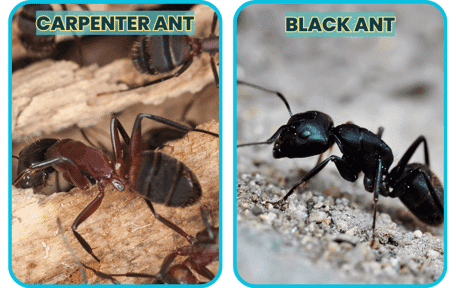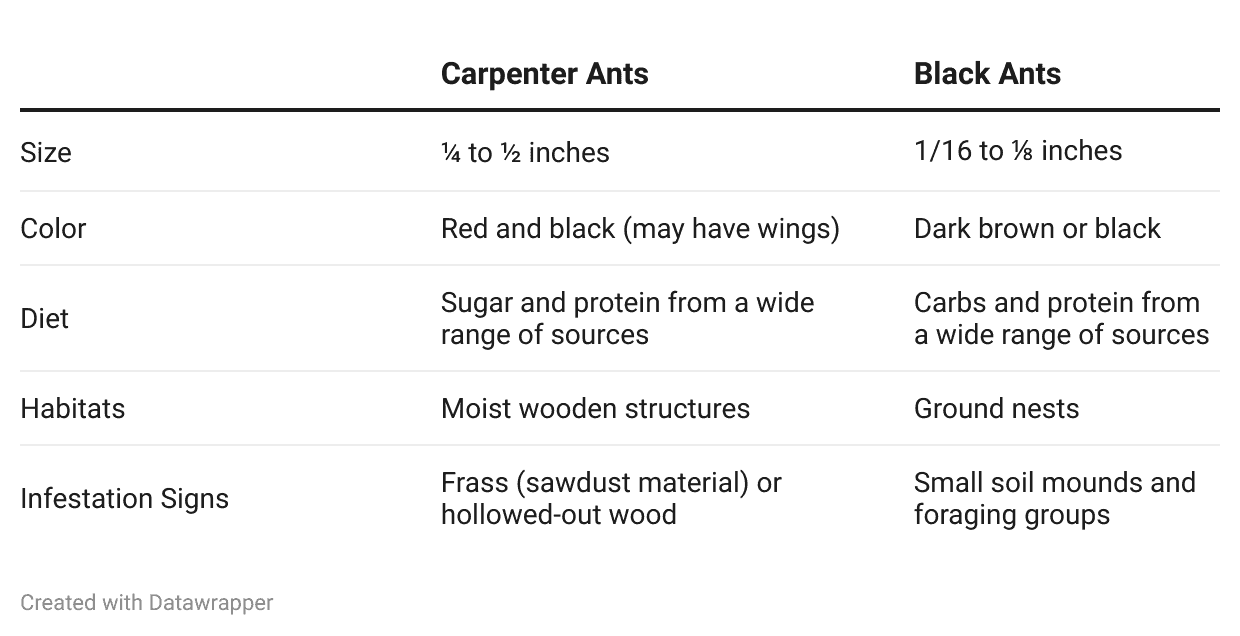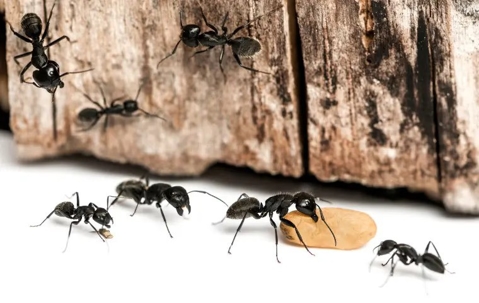Carpenter Ants vs. Black Ants: What’s the Difference?
Carpenter ants and black ants are common in North America, especially here in South Florida, and whether in your garden or along your kitchen baseboards, you’ve likely run into them before.
While they share similarities, as Florida homeowners, it’s important to understand the differences between them to know how to get rid of them.
Carpenter ants are known for their burrowing habits in wooden structures and can be identified by their larger size and segmented bodies. In contrast, black ants are often smaller and more versatile in their nesting preferences and are less likely to cause direct structural damage to wooden materials.
In this guide, we’ll explore the ins and outs of both types of ants to give you a better idea of how to manage potential infestations effectively.
Key Takeaways
- Carpenter ants are large and can damage wood, while black ants are smaller and less destructive.
- Black ants adapt to various environments, unlike carpenter ants that prefer moist wooded areas.
- Effective ant management requires distinguishing between these two common types of ants.
Carpenter Ants vs. Black Ants

Carpenter ants and black ants differ significantly in their physical characteristics and impact on human habitats. Understanding these differences is crucial for proper pest management.

Carpenter Ant Characteristics
Camponotus, commonly known as carpenter ants, are large, ranging from 0.3 to 0.5 inches long. They are usually red or black and may have wings.
Unlike termites, carpenter ants do not eat wood, but they hollow out wood to create nests, which can lead to structural damage. If you get a close enough look at a carpenter ant, you’ll also notice its heart-shaped head.
Black Ant Characteristics
Not to be confused with black carpenter ants, Lasius, or black ants, commonly called little black ants, are much smaller, ranging between 1/16 and 1/8 inch long. Their uniform dark brown or black color and smaller colonies make them less conspicuous. They are also highly adaptable and often less destructive to wooden structures than carpenter ants.
Comparing Habitats and Behaviors
- Carpenter ants favor moist wood and are often found in wooden structures or trees. They forage at night and are considered social insects, developing large, complex colonies.
- Black ants prefer to build their nests in the ground, creating characteristic mounds, and forage for food in long, visible trails. They are also social but tend to form smaller colonies than carpenter ants.
Carpenter Ants vs. Black Ants - Diets
Most carpenter ants feed on sugar and protein, which they get from a wide range of sources, including nectar, fruits, plant sap, or other dead insects. Contrary to popular belief, they do not consume wood, yet they do burrow through it to create small nests.
Black ants are less picky with their diet choices, consuming both carbohydrates and protein. They also feed on dead insects, though will also capture and eat live insects and honeydew, the sugary liquid waste produced by aphids.
Recognizing Signs of Infestation
The first thing to do when dealing with an ant problem is to recognize the species of ants you’re dealing with. Let’s explore what to look out for when trying to identify your ant problem.
For a carpenter ant infestation, look for:
- Frass (sawdust-like material)
- Smooth, hollowed-out galleries in wood
- Occasional sightings of large-winged ants
For a black ant infestation, look for:
- Small soil mounds
- Consistent and trails, especially near food sources
- Foraging groups
Other Types of Ants to Look Out For
Beyond your standard black ants and carpenter ants, there are a few other types of ants to look out for, including:
Odorous Ants
The odorous house ant is one of the most common house pests here in Florida. They usually build colonies with multiple nests, which can range from a few hundred to tens of thousands of individual worker ants.
While they won’t do significant damage like carpenter ants, they can be a huge nuisance, contaminating food while foraging.
These small insects range in color from black to brown and are often anywhere between 1/16 to 1/8 inches. They get their name from the fact that when smushed, they leave a coconut-like smell.
Pavement Ants
Pavement ants are also nuisance insects, getting their name from the fact that they often build their nests along the edges of hard surfaces like driveways or sidewalks.
They can be anywhere between 1/8 to 1/16 inches long with black or dark brown bodies. They’ll often enter homes through cracks in the foundation. One of the best ways to spot them is to look for small piles of sand or soil near cracks in the concrete surrounding your home.
Preventative Measures and Solutions
Before you bust out the insecticides or call your pest control professional, it’s important to note that ant control starts with preventative measures.
- Moisture control: Fix leaks and ensure good ventilation to reduce moisture, which attracts large numbers of ants.
- Keep Your Home Clean: Wash dirty dishes immediately and clean up pet food at the end of each day.
- Seal entry points: Caulk cracks and crevices to prevent ant entry.
- Natural remedies: Apply diatomaceous earth or boric acid around entry points, such as doorways and windowsills.
- Ant baits: Strategically place ant baits to eliminate colonies.
- Call the Exterminator: If the infestation persists, contact a professional exterminator for reliable pest control solutions.
Call Your Local Pest Control Professional
If you’re dealing with a serious ant infestation, the best thing you can do is get in touch with your local pest control specialist.
Our team at Native Pest Management has years of experience in dealing with pests of all shapes and sizes, so whether you’re dealing with a large carpenter ant colony, a nest of big black ants, or any other pests, from cockroaches to palmetto bugs, we can help.
We offer some of the best and longest-lasting pest control services here in West Palm Beach, FL, so give us a call today for a free quote!
Frequently Asked Questions
We get a ton of questions about how to keep pest-free homes here at Native Pest Management, so to help you out, we wanted to answer some of your most frequently asked questions.
How can you tell the difference between carpenter ants and regular black ants?
Carpenter ants are usually larger, with elbowed antennae and large mandibles ranging from 6 to 12 mm, while regular black ants are often smaller. They also have a more defined waist with a rounded thorax, unlike the uneven thorax of black ants.
What are some signs that indicate the presence of carpenter ants in your home?
Signs of carpenter ants include wood shavings below wooden items, a faint rustling sound within the walls, and seeing large colonies of winged ants, usually in the spring.
Can you find large black ants in your house that aren't carpenter ants?
Yes, they may encounter large black ants that aren't carpenter ants, such as the big-headed ant or the Lasius niger, which have different nesting habits.
What are some effective ways to get rid of carpenter ants?
Some of the best ways to get rid of carpenter ants include baiting, dusting, and sprays specifically formulated for carpenter ants. You can also use preventative home maintenance like moisture control to prevent infestation.
What should you do when you encounter black ants in your living space?
Start by identifying the type of ant and how many there are. If you’re only dealing with a few black ants, simply clean the house and get rid of any food sources. On the other hand, if you’re dealing with an infestation, you might consider professional pest control services.
